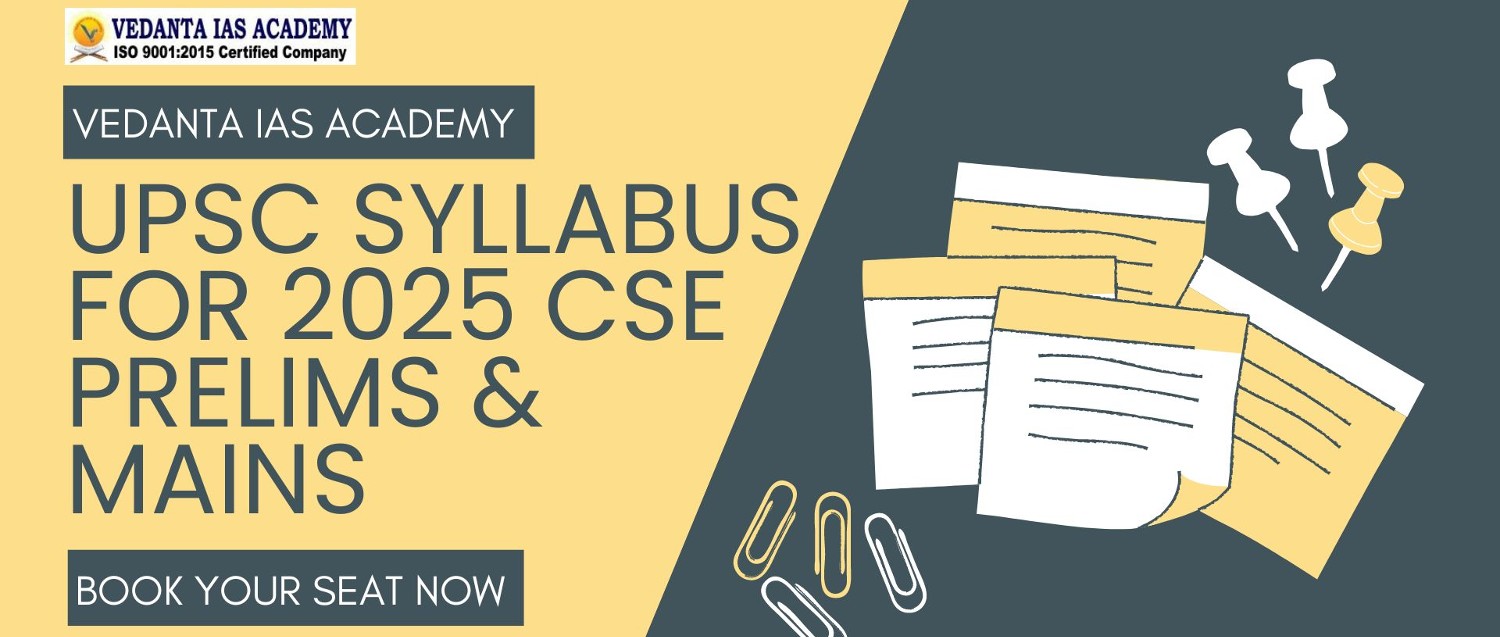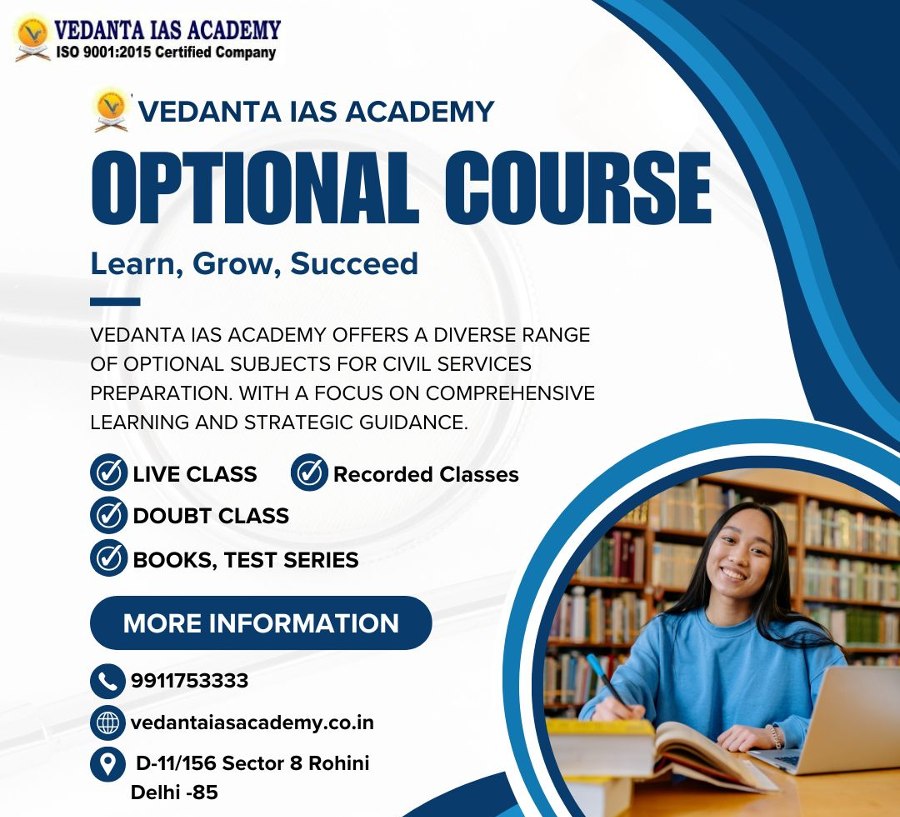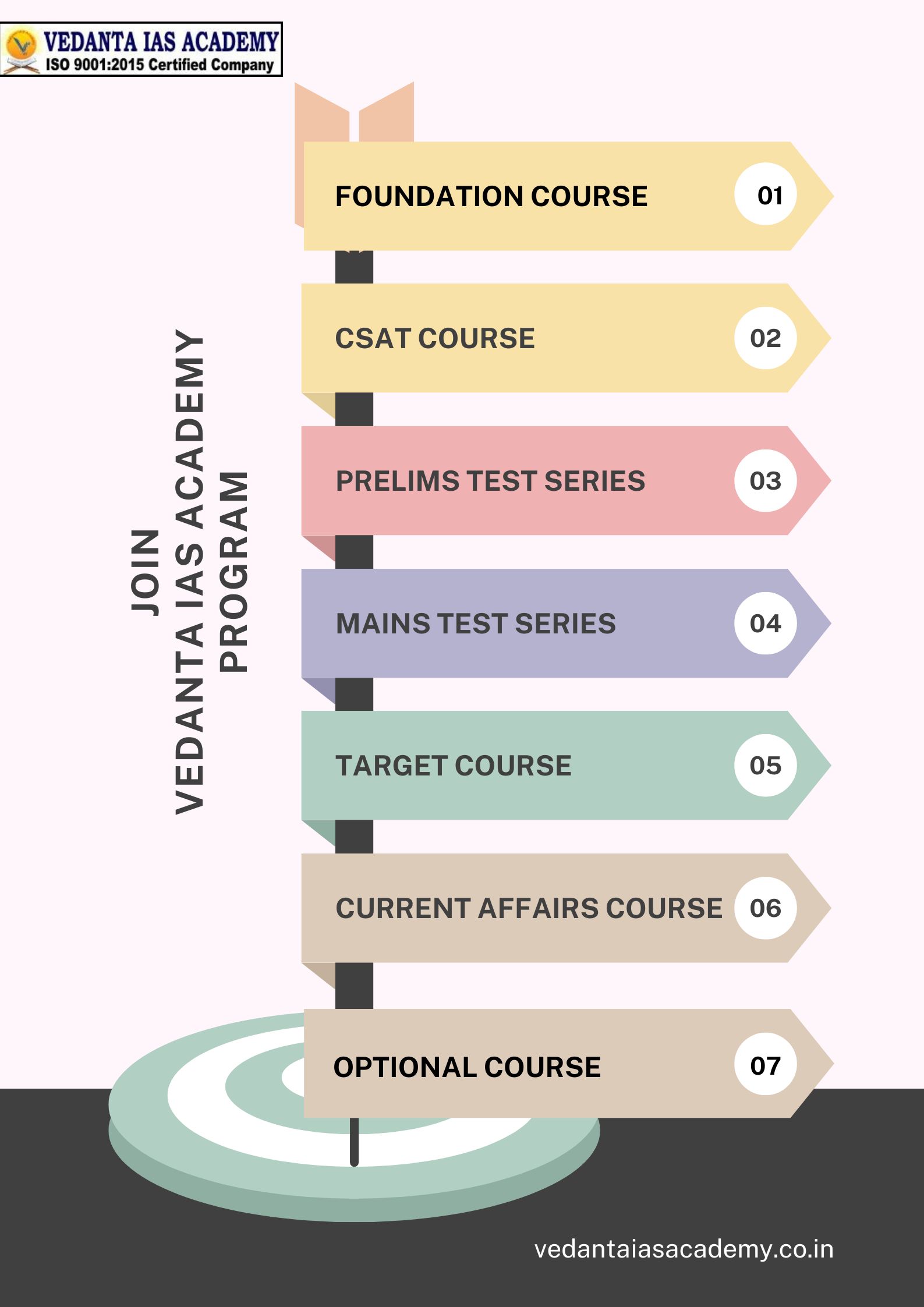
UPSC SYLLABUS
Author : HOD of Vedanta ABHISHEK SRIVASTAVA.

UPSC Exam Consists of Three Stages
Prelims, Mains, Interview
UPSC Exam Preparation Starts With UPSC Syllabus, we provide a complete syllabus with comprehensive language. You can find the latest and updated form of the UPSC Syllabus at www.vedantaiasacademy.co.in.
UPSC CSE Prelims Syllabus
The first state of upsc exams is Prelims. Every Year more than 10 Lakh candidates apply approximately. Every aspirant dreams of success in the upsc prelims.
Every candidate must pass upsc prelims to go to the mains examination which is the second round after upsc Prelims. It is a screening test, needed to qualify for the next stage UPSC Mains. Candidates must be aware of the full prelims syllabus before preparation and then move to the other.
Candidates are advised to start their preparation for the exams a year before. One year is a must need to prepare such a huge syllabus of upsc. Some candidate starts their preparation after the 12th standard. Early preparation is helpful for better scoring results.
Exam Pattern & Syllabus for UPSC Prelims |
|
|---|---|
| Two Paper Of Prelims | General Studies Paper-I |
| General Studies Paper-II (CSAT) | |
| GS Paper-I: Number of Questions | 100 |
| CSAT: Number of Questions | 80 |
| Total Number of Marks | "400" GS Paper-I – 200 Marks CSAT – 200 Marks |
| Negative Marking | ⅓ of the total marks allotted to the question will be deducted for every wrong answer |
| Time Allotted | Two hours each; GS Paper-I – 2 Hours (9:30 AM -11:30 AM) CSAT – 2 Hours (2:30 PM – 4:30 PM) |
Some Important Details of Prelims Paper I & Paper II
General Studies
GS test is the first paper of the Prelims Exams The first test of GS is intended to know the candidates' wide range of subject knowledge, such as history, geography, Indian politics, Indian economy, science and technology, environment and ecology, etc. And Current Affairs.
CSAT: Civil Service Aptitude Test
CSAT is an aptitude test for candidates to solve “reasoning and analytical” questions. It intends to test the candidate for “Reading Comprehensiveness” and “Decision Making” abilities. Negative marking is applied on the question as (1/3), that's why it is based on decision making.
UPSC Prelims Paper 1 Syllabus for GS
- Current affairs are national and international as well.
- History Of India and the Indian National Movement
- Indian and World Geography Physical, Social, and Economic Geography of India and the World.
- Economics and Social Development: Sustainable Development, Poverty, Inclusion, Demographics, Social Sector Initiatives, etc.
- Constitution, Political System, Panchayati Raj, Public Policy, Rights Issues, etc.
- General Issues: Ecology, Biodiversity, and Climate Change that do not require subject specialization.
- Science And Computer.
Important Links, PDFs, and Videos
| UPSC Syllabus For Geography | Foundation Batches |
|---|---|
| UPSC Mains GS | Unique Target Batches |
| YouTube Channel | Optional Batches |
| Free Video Class Live | CRASH COURSE |
UPSC Prelims Paper 2 Syllabus for CSAT
General Mental Ability
Numeracy ability(numbers and their relations, orders of magnitude, etc.)(Class X level),
Data
interpretation ability(Charts, Graphs, Tables, Data Sufficiency, etc - Class X level)
Comprehensive Reading
Interpersonal Skills With Communication Skills
Logical reasoning and Analytical ability
Decision-making and problem-solving
| IAS Mains Exam Pattern | ||
|---|---|---|
| Paper-I | Essay Write (Candidate can choose the language to Answer) | 250 |
| Paper-II | General Studies – I (Cultural, History & Geography of the World & Society, and Indian Heritage) | 250 |
| Paper-III | General Studies – II (Governance, Constitution, Polity, Social Justice & International Relations) | 250 |
| Paper-IV | General Studies – III (Economic Development, Technology, Biodiversity, Security & Disaster Management) | 250 |
| Paper-V | General Studies – IV (Ethics, Integrity & Aptitude) | 250 |
| Paper-VI | Optional Subject – Paper I | 250 |
| Paper-VII | Optional Subject – Paper II | 250 |

Must-Know Facts about UPSC Mains
Some Important Points To Remember For UPSC Mains
- Candidates who qualify for prelims take mains exams only. It is a written exam and also the second phase of upsc exams.
- The UPSC mains exam tests the candidates’ in-depth knowledge of subjects and topics. I also understand according to the given time.
- The UPSC Mains exam consists of a total of 9 papers, two of which are qualifying papers with about 300 marks each.
Two Papers are:
I. Anyone Indian Language Paper
II. And English Language Paper
Candidates only who achieve the required qualifying standard of 25% in both language papers will have their essays, general studies papers, and optional subjects taken into consideration for assessment.
A candidate's marks will not be taken into account or tallied if they are ineligible for certain language exams.
UPSC Mains Syllabus GS-1s
- UPSC Mains Paper-2 Syllabus. It covers complete information about the culture, history, Geography India, and world. It covers Indian Heritage and Society.
- Indian Culture covers Art Forms, Literature, and Architecture from ancient to modern times.
- Modern Indian history - significant events, personalities, and issues- from medieval to modern.
- Modern history - Important events, personalities, and issues.
- The Freedom Struggle.
- Post-Independence, 550 Princely States, recognized states based on the language, Economic, and Social reforms.
- World History 18th century - Industrial Revolution, world war, national boundaries, colonization, political philosophies: communism, capitalism, socialism.
- Significant features of Indian Society, Diversity of India.
- Women’s role in society, organization, population and associated issues, poverty, developmental issues, urbanization, problems and their remedies.
- Effects of globalization on Indian society.
- Communalism, Social empowerment, regionalism & secularism.
- World’s Physical Geography.
- Important aspects of the physical geography of the world.
- The global distribution of important natural resources, encompassing South Asia and the Indian subcontinent, is one of the variables that determines the location of primary, secondary, and tertiary sector industries around the globe, including India.
- Critical geographical characteristics (such as ice caps and water bodies), as well as the effects of such changes on flora and fauna, are examples of important geophysical phenomena. Other examples include earthquakes, tsunamis, volcanic activity, cyclones, and other natural disasters.
IAS Syllabus for Mains GS-II
UPSC Mains Paper-III is another name for General Studies-II. International relations, social justice, politics, governance, and the constitution are the main topics covered. Below is the comprehensive UPSC syllabus for this particular paper:
- India's Constitution: its background, development, characteristics, modifications, key clauses, and overall framework.
- Duties and obligations of the Union and the States, problems and difficulties with the federal system, the devolution of funds and authority down to the local level, and difficulties associated with it.
- Power disparities amongst different organs raise issues with institutions and procedures for dispute resolution.
- Power disparities between several organs cause problems for dispute resolution processes and institutions.
- The composition, operations, business practices, rights and privileges, and consequences of the legislatures of the states and the parliament.
- Pressure groups, official and informal associations, and the role they play in politics are all examples of the structure, organization, and operation of the Executive and Judicial branches of government.
- Important aspects of the Act for the Representation of the People.
- appointment to different constitutional positions and the authority, duty, and jurisdiction of different constitutional bodies.
- regulatory, statutory, and other quasi-judicial organizations.
- Government initiatives and programs for development across a range of industries, as well as the problems they create and carry out.
- NGOs, SHGs, diverse groups and alliances, funders, charities, institutional and other stakeholders—the involvement of these entities in the development industry and its processes.
- The function of NGOs, SHGs, diverse groups and associations, donors, charities, institutional and other players, as well as development processes and the development industry.
- Policies, Laws, Organizations, and bodies established for the protection and betterment of these vulnerable groups; welfare programs for the most vulnerable segments of the population by the federal government and the states; and the implementation of these policies.
- Topics about the establishment and administration of the social sector and services in the fields of education, health, and human resources.
- Problems with hunger and poverty.
- Crucial elements of government, accountability and transparency, e-governance models, applications, achievements, drawbacks, and possibilities; citizen charters, accountability, and transparency, institutional, and other measures.
- Civil services function in a democracy.
- India and its relationships with its neighbors.
- Agreements and alliances on a bilateral, regional, and international level that concern India or have an impact on its interests.
- The impact of developed and developing countries' policies and politics on India's interests and the Indian diaspora.
- Prominent global organizations, councils, and forums: their composition and purpose.
IAS Syllabus for Mains GS-III
The UPSC Mains Paper-IV is also known as General Studies-III. Technology, economic development, biodiversity, environment, security, and disaster management are the main subjects studied. Below is the comprehensive UPSC syllabus for this particular paper:
- The planning, resource mobilization, growth, development, and employment aspects of the Indian economy.
- Inclusive growth and the problems it raises.
- Governmental Financial Planning.
- Principal crop-cropping patterns across the nation; diverse irrigation types and methods; storage, transportation, and marketing of agricultural products; problems and associated limitations; e-technology to support farmers.
- Direct and indirect farm subsidies, minimum support prices, buffer stock, food security, Public Distribution System goals, operations, constraints, redesign, technology missions, and the economics of animal husbandry are all topics of discussion.
- The extent, significance, location, upstream and downstream requirements, and supply chain management of India's food processing and allied businesses.
- Indian land reforms.
- Economic impacts of liberalization, modifications to industrial policy, and how these affect the expansion of the industrial sector.
- Ports, roads, airports, trains, and energy are examples of infrastructure.
- Models of investments.
- Innovations in science and technology, as well as how they are used and impact daily life.
- Scientific and technological accomplishments of Indians; creation of new technologies and indigenization of existing technology.
- Knowledge in the areas of information technology, computers, robots, nanotechnology, biotechnology, and intellectual property rights.
- Environmental impact assessment, conservation, and pollution and degradation of the environment.
- catastrophes and their management.
- connections between the rise and dissemination of extremism.
- The involvement of external state and non-state entities in posing obstacles to domestic security.
- Communication networks' challenges to internal security, the media's and social media sites' roles in these difficulties, the fundamentals of cyber security, and the avoidance of money laundering are addressed.
- Organizational crime and terrorism: links between security concerns and their handling in border areas.
- The missions of the various security units and agencies.
UPSC Mains GS Syllabus - IV
- Ethics and Human Interface: The nature, factors that influence, and results of ethics in human behavior; ethics' dimensions; ethics in interpersonal and public spheres. Human values include the lessons learned from the examples of great administrators, reformers, and leaders as well as the importance of family life and educational institutions in fostering moral principles.
- Moral and political attitudes, social influence and persuasion, substance, structure, and function of attitudes, as well as their relationship to cognition and conduct, are described.
- The ability to perform civil service work with honesty, impartiality and nonpartisanship, objectivity, commitment to public service, empathy, tolerance, and compassion for the underprivileged.
- Concepts of emotional intelligence and how they might be used in governance and administration.
- contributions from philosophers and moral thinkers throughout the world, including India.
- Status and issues; ethical concerns and dilemmas in public and private institutions; laws, rules, regulations, and conscience as sources of ethical guidance; accountability and ethical governance; fortifying moral and ethical values in governance; ethical issues in international relations and funding; corporate governance. Public/Civil Service Values and Ethics in Public Administration.
- The notion of public service; the philosophical underpinnings of governance and probity; information sharing and transparency in government; the right to information; codes of ethics and conduct; citizen charters; work cultures; the standard of service delivery; the use of public funds; and the difficulties associated with corruption are all examples of probity in governance.
- Case Studies of the aforementioned concerns.

UPSC Language And Essay Paper Syllabus
UPSC Mains Essay Paper - 1
It may be necessary for candidates to produce essays on a variety of subjects. They will be asked to write succinctly, organize their thoughts logically, and stay close to the essay's topic. Give credit where credit is due for clear and precise expression.
Language Paper Struture:
The types of questions asked are:
- Essay – 100 marks
- Reading comprehension – 60 marks
- Precis Writing – 60 marks
-
Translation:
- English to compulsory language (e.g. Hindi) – 20 marks
- Compulsory language to English – 20 marks
- Grammar and basic language usage – 40 marks

UPSC Optional Subject Syllabus
There is a list of 48 optional subjects in UPSC Mains.
| List of Optional Subjects Available for the UPSC Civil Services Mains Examination. | |
|---|---|
| Optional Subject | Optional Subject |
| Agriculture | Anthropology |
| Animal Husbandry and Veterinary Science | Botany |
| Chemistry | Civil Engineering |
| Commerce and Accountancy | Economics |
| Electrical Engineering | Geography |
| Geology | History |
| Law | Management |
| Mathematics | Mechanical Engineering |
| Medical Science | Philosophy |
| Physics | Political Science and International Relations |
| Psychology | Public Administration |
| Sociology | Statistics |
| Zoology | Assamese (Literature) |
| Bengali (Literature) | Bodo (Literature) |
| Dogri (Literature) | Gujarati (Literature) |
| Hindi (Literature) | Kannada (Literature) |
| Kashmiri (Literature) | Konkani (Literature) |
| Maithili (Literature) | Malayalam (Literature) |
| Manipuri (Literature) | Marathi (Literature) |
| Nepali (Literature) | Odia (Literature) |
| Punjabi (Literature) | Sanskrit (Literature) |
| Santhali (Literature) | Sindhi (Literature) |
| Tamil (Literature) | Telugu (Literature) |
| Urdu (Literature) | English (Literature) |
Interview Syllabus For UPSC Exams
The UPSC Interview also referred to as the Personality Test, is the concluding part of the test. The UPSC interview syllabus is not set in stone. Numerous topics are covered in the questions posed.
- A panel of knowledgeable and objective observers will evaluate the candidate's suitability for a career in the civil service as part of the interview process.
- The purpose of the interview is primarily to examine the candidate's mental faculties and analytical skills.
- There will be a 275-point interview exam in addition to a 1750-point written exam. This adds up to a total of 2025 marks, which will be the foundation for creating the final merit list.

Foundation Course : UPSC 2026

Foundation Course : UPSC
Vedanta IAS Academy
1,41,000/-
1,06,000/-

Optional Batch : UPSC 2025

Optional Batch : UPSC
Vedanta IAS Academy
47,000/-
35,000/-










